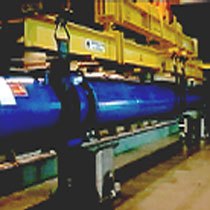2007年VOA标准英语-Massive Research Project Nearing Completion(在线收听)
Washington
11 July 2007
The world's largest particle physics laboratory is under construction on the border between Switzerland and France. At the heart is the Large Hadron Collider Particle Accelerator being built by the European Organization for Nuclear Research (CERN). Its members hope it will reveal secrets of the universe and its formation. VOA's Paul Sisco has more.
The goal of the project is to discover the origin of matter by replicating conditions just after "the big bang."
 |
| The particle accelrator is in a 27 kilometer tunnel |
The particle accelerator and collider is a 27 kilometer tunnel, about 100 meters underground. CERN spokesman James Gillies describes the accelerator. "This is a discovery machine. It's built to make discoveries and is going to tell us lots of new things about the universe."
If all goes as planned, subatomic particles will be accelerated around the tunnel next year, eventually approach light speed, and smash into one another.
Gillies adds, "To me the most exciting thing is that we know an awful lot about a small amount of the universe. We understand the stars, the galaxies, the stuff which makes up you and me, but we also know from cosmology that is about four percent of what must be out there, and this machine might help us take steps in understanding the remaining 96 percent of the universe."
More than 35,000 tons of material went into the underground lab. CERN Engineer Johan Dhote says, "I have worked on the magnet for two year, many hours went into this. Some conflicts from time to time as in all workplaces, but very good teamwork."
Nearly 8,000 scientists and engineers from 500 universities and 80 nations work at the international facility, making CERN, by far, the largest particle physics laboratory in the world.